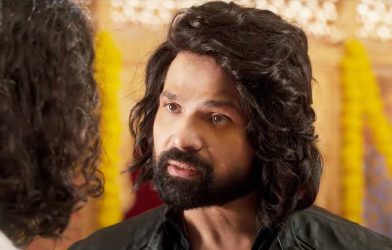Mumbai, India
CNN
—
For nearly a century, Bollywood has held a mirror to Indian society, the plotlines of the world’s most prolific movie industry reflecting the changing tides of a vast, developing nation.
India’s multibillion-dollar movie industry produces around 1,500 to 2,000 films per year in over 20 languages – more than any other country. And most of these are Hindi films, meaning Bollywood holds an outsized influence on the country’s culture, identity and economy.
And while the industry is perhaps most famous for its lavish musical productions, many films also tackle the political, religious and social issues of any given era.
But where Hindi cinema once reflected certain secular, democratic values championed by India’s founding fathers, many critics say the industry has veered toward the right over the past decade – coinciding with the populist rule of Prime Minister Narendra Modi and his Hindu-nationalist Bharatiya Janata Party (BJP).
Alarmed liberals and some industry insiders point to a string of recent blockbusters that they say perpetuate anti-Muslim stereotypes and sideline opposition views. While they only represent a fraction of movies produced each year, they receive outsized publicity and sometimes government support – and critics worry they serve as propaganda tools for the BJP as it aims to win a third straight term in ongoing nationwide elections.
Observers and insiders say the change is profound – as if Hollywood was increasingly pandering to the Republican party’s most right-wing sensibilities.
These types of films swap the common romantic heartthrob archetype with heroes that champion Modi’s Hindu-first policies, and villains are almost always Muslims who threaten the country’s majority-Hindu population. Even movies without a religious lean are being used to amplify the BJP’s domestic policies, critics say.
Indranil Mukherjee/AFP/Getty Images
Moviegoers wait outside a movie theatre screening of “The Kerala Story” in Mumbai, India on May 10, 2023.
“There are a lot of these releases coming out now,” said award-winning director Raja Sen in a video interview. “It’s not the kind of thing that you should be allowed to do in an election year.”
With voting underway in the world’s most populous nation, a significant portion of its more than 200 million Muslims have voiced fear over Modi’s widely expected victory. They cite sweeping BJP changes to legislation that human rights groups say unfairly target followers of the minority faith, along with a rise in anti-Islamic rhetoric.
While films echoing the ruling party’s views are not produced or directly funded by the BJP, many of them are publicly endorsed by the government – some by Modi directly.
Though divisive, the prime minister enjoys enormous support across the country thanks to his economic wins, overseas diplomacy and brand of Hindu nationalist populism. Modi’s seal of approval can therefore boost a movie’s audience and bring commercial success, experts say, all while pushing anti-Muslim narratives into the mainstream and deepening India’s religious divide.
“I have seen firsthand this tidal change in popular Hindi cinema, of films not just toeing the government line, but also just becoming … more and more vile,” said Tanul Thakur, a film critic and journalist based in Mumbai, the home of Bollywood, in a phone interview.
“The degree to which we are seeing the infusion of politics in popular Hindi cinema, coupled with … this very blatant disregard for India’s religious minorities, and any kind of multiplicity of narratives … has been very disconcerting.”
CNN has reached out to the Ministry of Culture, the BJP, and the regulatory Central Board of Film Certification for comment on the claims made by critics in this story.
A BJP national spokesperson has previously told CNN the party is not prejudiced against Muslims, and the community has benefited from Modi’s leadership, saying: “India’s constitution protects the Indian democracy.”
Every expert who spoke with CNN agreed that the production of pro-government and anti-Muslim movies has accelerated during Modi’s time in office.
They pointed to a number of recent releases that pushed that agenda – including this year’s “Swatantrya Veer Savarkar,” a biopic of a leading figure in India’s Hindu-nationalist movement, and the upcoming “JNU,” which critics worry will demonize the titular university known for left-wing student activism.
Two of the most famous examples are “The Kashmir Files” of 2022 and “The Kerala Story” of 2023, which were both criticized for vilifying Muslims, perpetuating negative stereotypes, worsening religious tensions and distorting historical facts.
Both were also massive box office successes – “The Kashmir Files” raked in over $30 million on a $3 million budget – in part because they received enthusiastic government praise.
While the BJP didn’t fund the productions, prominent party politicians, including Modi, publicly endorsed the two movies, and some BJP-ruled states waived tax on tickets for both. Other states gave police officers and government workers time off to watch “The Kashmir Files.”
IMDB
Adah Sharma in “The Kerala Story” (2023).
“The Kashmir Files” was based on the mass exodus of Kashmiri Pandits – members of Hinduism’s highest caste, the Brahmin, or “priestly class” – from the restive region as they fled violent Islamist militants in the 1990s.
It was well received in many quarters with praise for the actors’ performances, especially from some Kashmiri Hindus who claimed the film shed a light on a neglected period of their history. Its director, Vivek Agnihotri, has repeatedly rejected criticism of the movie, telling CNN in 2022: “The film is only against terrorism. I have not criticized Muslims.”
Sudipto Sen, director of “The Kerala Story,” has similarly denied that his film propagated Islamophobia, telling local media “It has nothing to do with any religion.”
Then there’s the recently released “Article 370,” also endorsed by Modi, named after the Indian government’s controversial 2019 decision to remove the special autonomy of the country’s only Muslim-majority state, Jammu and Kashmir. Some media and rights groups slammed the government’s heavy-handed crackdown at the time, while critics of the film argued it distorted the facts and drove a government narrative that the move was essential.
Imdb
A screengrab from the 2022 Bollywood film “The Kashmir Files.”
Critics say these types of movies stretch back years during Modi’s tenure – with a similar spate of pro-government films that sprung up around the 2019 election season, including a glowing biopic of the prime minister himself which was ultimately held for release until after polls closed, due to concerns it would serve as political propaganda.
Though nationalist movies rarely attract direct political backing, support from the government may also take the form of what is and is not shown in theaters. The country’s strict national censor board can pull movies from cinemas or ban them from release, with reasons ranging from religious objections to accusations that plots are “obscene” or “immoral.”
The impact of Bollywood’s transformation has been profound – with far-right Hindu nationalists attacking movies that offend their sensibilities, such as those critical of the government or depicting Hindu-Muslim unity.
Experts say it has forced filmmakers to self-censor and streaming platforms to fall in line – with several high-profile instances in recent years of India’s entertainment industry facing pressure campaigns from religious groups.
They include Netflix’s 2020 show “A Suitable Boy,” which depicts a young Hindu woman being kissed by a Muslim man at a Hindu temple, and Amazon’s 2021 series “Tandav,” which included depictions of some Hindu deities. Another example is this year’s release of Netflix’s “Annapoorani: the Goddess of Food,” which follows a high-caste Hindu woman cooking and eating meat as she trains to become a chef.
In all three instances, the filmmakers faced backlash from far-right Hindu nationalists and politicians who called for boycotts and filed police complaints against the streaming platforms and production companies. Netflix later removed “Annapoorani” from its platform, saying it had been pulled “at the request of the licensor.”
Lookout Point
A screengrab from the Netflix series “A Suitable Boy,” which faced religious backlash.
Objections to movie storylines on religious grounds date back as far as the colonial era, says Debashree Mukherjee, an associate professor at Columbia University’s department of Middle Eastern, South Asian, and African studies.
But what’s happening now is different because it’s not just individuals taking offense – rather, “the forces that are actually in power and in the demographic majority are crying wolf in order to completely silence any minority voices,” she said in an email interview.
Thakur and Sen both lamented the self-censorship that has ensued, saying there may be countless filmmakers and artists concerned about these issues who feel unable to speak out – which can come at a hefty cost.
Movies are expensive to make, meaning there’s little incentive for filmmakers to produce controversial movies that could be pulled from streaming platforms or censored by authorities – especially for independent creators without much funding, says Darab Farooqui, a screenwriter based in Jaipur and Mumbai.
Under Indian law, insulting “religious feelings” is punishable by up to three years in prison and/or a fine.
Sonu Mehta/Hindustan Times/Getty Images
Members of the Social Democratic Party of India protesting “The Kashmir Files” and demanding a ban on the movie in New Delhi, India on March 19, 2022.
And, Farooqui says, there’s the personal toll of being targeted by the far-right.
“There are going to be articles in right-wing publications, there are going to be character assassinations,” he told CNN in a phone interview. “Imagine your son or your daughter is now in college, and she’s being told by her friends, ‘What is wrong with your father, your father has turned anti-national’ … you don’t want to put your kids through that.”
Even Bollywood’s biggest names aren’t spared. Muslim superstar Aamir Khan was dropped from two brand ambassadorships, including the government’s own tourism body, after speaking out about “growing intolerance” in 2015, according to local media reports.
Now, within India’s arts and film community, “even those people who used to talk a lot very openly … a lot of them have gone quiet now,” Farooqui says.
CNN reached out to several people from the film industry for this story, some of whom declined to be interviewed due to sensitivities around the topic.
Bollywood wasn’t always this way.
Many of its prominent early filmmakers were influenced by the country gaining independence from British rule in 1947 and the bloody partition that ensued – sending Muslims to the newly formed nation of Pakistan, while Hindus and Sikhs fled to India.
The traumas of Partition and religious violence, as well as the secular values enshrined in India’s constitution and championed by its first Prime Minister Jawaharlal Nehru, shone in early Bollywood movies – with a “new round of Hindu-Muslim brotherhood films” in the 1950s, says Mukherjee, the associate professor at Columbia University.
In that era, she adds, Bollywood was “a very mixed scene with a cacophony of voices,” including renowned directors like Yash Chopra. His films often depicted romantic and familial relationships between Hindus and Muslims, making “deeper comments against social and religious prejudice.”
That’s not to say all early Bollywood films preached harmony; over the decades, there were patriotic films about India-Pakistan conflicts that cast Muslims or Pakistan as the villain, often reflecting Delhi’s foreign policy stance at various times.
Raja Sen, the director, argues the 9/11 attacks in the United States and the ensuing wave of Islamophobia in the West also seeped into Hindi films. It encouraged some Bollywood filmmakers to “(lean) into the caricature of the Muslim villain,” he says.
The shift we’re seeing now is a far cry from earlier decades when governments offered tax waivers for “safe films that would tackle, say, the evils of caste system,” says Thakur, the journalist, referring to India’s 2,000-year-old social hierarchy imposed on people by birth that still exists in many aspects of life, despite being officially abolished in 1950.
The films that used to receive government support “spoke largely for the nation, films that spoke about something that we could all be unified about,” Thakur adds.
India’s shift to the right has had a widespread impact on the creative arts, according to Sen.
He points to drama schools clamping down on what students can watch or produce, and the detention of comedians for allegedly hurting religious sentiment.
Journalists have also voiced alarm over the decline of press freedoms under Modi’s government.
“Over the last three or four years, we started seeing … a crackdown in a lot of creative output,” Sen says. “We’ve always had a lot of arbitrary (censorship), but I think now is where it started really getting after specific examples (of), ‘You will not be anti-government.’”
Noemi Cassanelli/CNN
A woman walks past a mural portraying Bollywood Indian actor Dharmendra in Mumbai, India, on April 17, 2024.
With avenues for dissent shrinking within Bollywood, independent filmmakers are now looking instead to regional Indian cinema, filmed in local languages away from the industry’s traditional center of Mumbai. These films are growing fast; outside Bollywood, earnings from the South Indian media and entertainment industry have nearly doubled year on year, according to a 2023 report by the Confederation of Indian Industry. And these regional sectors offer space for bolder stories, especially in states not ruled by the BJP.
Tamil and Malayalam cinema – mainly based in the southern states of Tamil Nadu and Kerala, neither of which is governed by the BJP – both “do a fairly good job” of allowing plural, critical voices, says Farooqui.
And it’s “because they have political protection – they have their governments there,” he says. “You cannot have great art without political protection.”
But the prospect of another five-year term for Modi and the BJP has filled some filmmakers with pessimism about Bollywood’s near-term future.
“Something’s definitely got to give,” Sen says. “I think we are at a point where, over the next couple of years, if this government does return this year, then the oppressiveness on creativity is going to just increase.”









